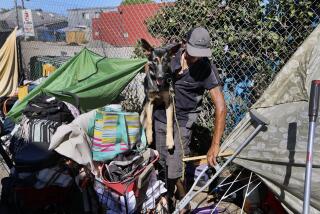Homeless Tally Still Unfinished
- Share via
The daunting task of trying to count homeless migrant workers in the fields and canyons of North County proved overwhelming last week, as many social service providers had predicted.
So, the news that there would be a recount of some of the camps was welcome. Head counts had been made instead of face-to-face interviews in too many cases, leaving the census without much of the important demographic information that is normally gathered, officials said.
There would be retraining, more Spanish-speaking counters and “much, much closer supervision,” census officials said.
We had hoped that the recount would also provide a chance to refine the procedures used to find the camps, which appeared seriously inadequate given the extreme difficulty of the job.
Times staff members who observed some of the count in the dawn hours Wednesday saw many more problems than just a lack of face-to-face interviews. There were too few workers spread over too much space with too little time to hike into the remote camps. Some of the enumerators did not know what to look for. The “camps” are scattered lean-tos, holes in the ground, or bedding in a bush. It takes a trained eye to spot them.
Enumerators themselves pointed out some of these problems to census officials.
But instead, census officials hurriedly recalled their enumerators and sent supervisors out for about an hour to get a better handle on camp locations. More supervisors and Spanish speakers were added, there was a three-hour training session in the middle of the night, and the counters were back in the fields early Friday morning.
The goal was not to go to additional sites or to find additional migrants, but to go back to the same sites and try to get more information.
But late Friday, regional census officials acknowledged that they did not have enough workers still and that more enumerators would be sent out this week.
That’s not surprising.
In 1980, a team of census takers had four months to count the migrants. They got to know the area and could follow the catering trucks and learn where people were and how to get to them. It is understandable that the Census Bureau wanted to shorten the time frame. It worked hard on developing the procedure for this first, comprehensive homeless count.
But the agency ignored too much valuable advice from social service providers who work with this population every day.
One of those suggestions was to spread the count over several days or weeks and to hire guides or social service agencies to help enumerators find the migrants. That makes logical and financial sense.
About $200 in state and federal funds is at stake for every person counted--money that could be used to help provide services for this very needy population. It is also important that San Diego County have as accurate a picture of this population as possible, and the 1990 census is the best way to accomplish that.
Census officials surely learned much from this year’s unprecedented homeless count that will help with future censuses. But we would urge census officials to apply what they have learned while there is still time for this census. Extending the count is a start. Now they should sit down with social service providers and make use of their experience. It’s not too late.
More to Read
Sign up for Essential California
The most important California stories and recommendations in your inbox every morning.
You may occasionally receive promotional content from the Los Angeles Times.










